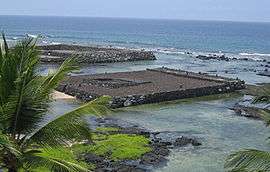Luakini
In ancient Hawaii, a luakini temple, or luakini heiau, was a Native Hawaiian sacred place where human and animal blood sacrifices were offered.

Hāpaialiʻi and Keʻeku Heiau (above, left) on Kahaluʻu Bay
In Hawaiian tradition, luakini heiaus were first established by Paʻao, a legendary priest credited with establishing many of the rites and symbols typical of the stratified high chieftainships of the immediate pre-European-contact period.[1]
List of currently known or reputed luakini heiaus:
- Puʻu O Mahuka, "Hill of Escape"[2]
Maui:
- Loaloa Heiau
- Puʻukohola National Historic Site[3]
- Moʻokini, birthplace of Kamehameha I[4]
- Aha'ula[1] (now engulfed by lava)
- Keʻeku Heiau on Kahaluʻu Bay[5]
References
- "Pa'ao From Thrum, Emerson, and Kamakau". Hawaiian Voyaging Traditions. Retrieved 27 May 2018.
- Fournier, Rasa. "Hiking Puu O Mahuka Heiau". Hawaii.com. Retrieved 27 May 2018.
- "Chapter VII: Pu'ukohola Heiau National Historic Site". National Park Service. Retrieved 29 May 2018.
- Van James, Ancient Sites of Hawaiʻi, 1995, Mutual Publishing, ISBN 978-1-56647-200-5, page 143
- "Hoʻihoʻi Kulana Wahi pana - Restoring Sacred Places" (PDF). Kamehameha Investment Corporation. 2008. Retrieved 2009-12-28.
This article is issued from Wikipedia. The text is licensed under Creative Commons - Attribution - Sharealike. Additional terms may apply for the media files.